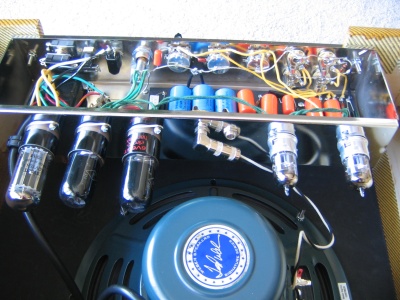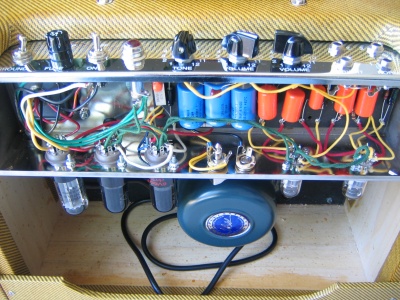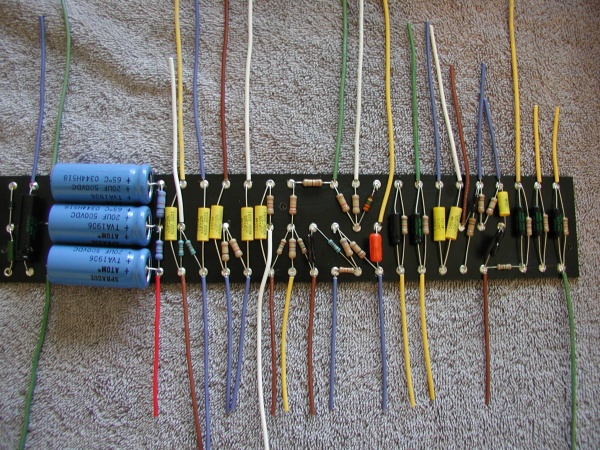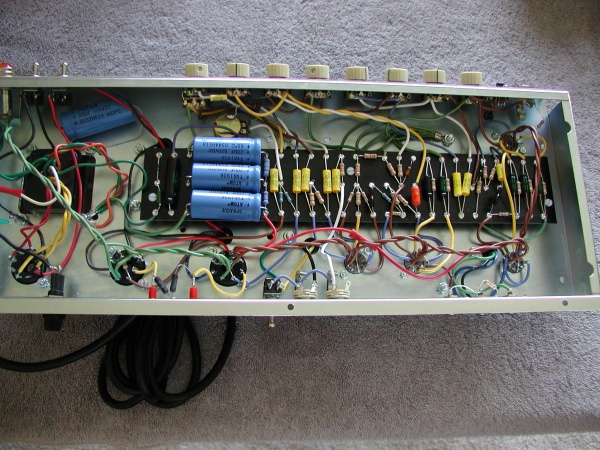Do It Yourself Tube Amplifiers
Weber 5C5 Pro
This is the first
Weber kit that I have completed. I chose this kit
because it was simple, nearly as simple as a 5E3, but different. I
liked the potential of the 6SL7 input stage and the cathode biased 6L6
outputs.
Ted Weber kits come with a
schematic, a layout, and a web based
community support forum. No real instructions, no formal support. The
forum works great sometimes, not so great other times, so you better
have a pretty good idea what you are doing before you launch into one of
these kits. The benefit though is the best price around.
This kit went together well for me. It worked on power up after I
sorted through some bad tubes, and the sound is pure vintage 50's. The
15" speaker is smooth and really sings. The old-fashioned Tweed circuit
alsways has a little crunch, and supplies everything from jazz approved
swing to cut-throught-the-band rock. I
will probably do some more work later to replace some critical
connectins with shielded wire and reduce the hum.
Weber Pro Construction
Standard tweed style techniques required here. Be warned that Ted's
kits never ship with enough wire, so stock up. Also, my experience is
that although all the components are serviceable, the switches, jacks,
and knobs can be easily upgraded to make for a better feeling amp.
Marsh Amplification Tweed Deluxe
Mike
Marsh
puts together a package of
high quality components, supports his customers until the amp is
complete, and does it all at a good price. He uses Mojo transformers,
orange drop capacitors, and Weber Signature Series Alnico speakers.
The tubes that came with the kit were two JJ 12AX7s, two
ElectroHarmonix 6V6s
(Sovtek), and a Sovtek 5Y3.
The design is classic mid-fifties
Fender 5E3; I even used the original schematic and layout. These amps
are as simple as can be. They have two channels, each with their own
volume control. One channel (“bright”) has a high
frequency
bypass around the volume control, and hence has more high end content
than the other channel (“normal”). Each channel has
two input
jacks, one of which attenuates the signal. The input jacks are
connected in parallel, so if you plug into one jack, the signal is
available as an output on the other jack. You can use this feature to
connect to both channels simultaneously (“jumpered
channels”).
I
had never heard one of theses amps
before, so when I powered up my kit and plugged in I was stunned!
Although these guys are usually rated at 15W, it is much bigger
sounding and louder than I expected. Side by side, it is louder than
my already loud 22W Fender Deluxe Reverb Reissue, and it hangs with
my 40W ’65 Bandmaster with two 12’s.
The normal channel is fat and smooth,
and is currently my favorite with a Strat. The bright channel is
snappy, clear, and jangly, and also sounds pretty darn good for my
Strats. The tone control yields a wide range of sounds for both
channels. Jumpering the channels gives up a whole new range of tone.
The output of the two channels add together so more gain is on tap,
and the two channels volumes can be adjusted for the just the right
combination a smooth and bite. This baby has fantastic tone and if
you have never played a good 5E3 before, you really owe it to
yourself to try one.
Here
are some clips of me playing.
I think the great tone of
Mike’s
incarnation of the 5E3 Deluxe is due to his component selection,
particularly the Ted Weber Signature alnico speaker.
Marsh Construction
Building a Tweed style amp isn’t just
about soldering components to a board. To me, the challenges were
mechanical: drilling holes in the chassis for the ground connection,
and working in the very confined space of the chassis. Mike’s
instructions, although brief, give good advice in these areas, and
others, such as grounding technique and construction sequence. After
working through this kit, I feel that I am up to the task of
completing more complicated designs.


Allen Amps Accomplice
David Allen makes
beautiful amps and
also sells kits of some of his models. His design ideal is the
Blackface era Fender amps, so all of his amps are based on Brown and
Blackface designs with significant enhancements to add versatility,
tone range, and combinations of features that Leo never made, but
would certainly approve of.
When you purchase one of his amps on
kit form, the instructions and support are truly exemplary. The
detail and precision of his construction tips, instructions, and
schematics are unparalleled. If you have never built an amp before,
these kits a re a great way to start.
I built an Allen Accomplice, which is
loosely based on the Deluxe Reverb, but with only one channel, an
added bright switch, mid control, a “raw” control
(which adds a
bit of tweed or Marshall feel), a reverb tone control, and a master
volume. There is no tremolo. The master volume is a post phase
inverter type, not found on any major brand amp that I know of, and
is really transparent.
My finished product is a totally
professional quality amp, no thanks to my skills, but due only to
David Allen’s perfectionism in assembling the components and
writing the instructions.
Allen Construction
These kits are so well put
together,
that basically you just need to follow the instructions and you will
have a fantastic and professional amp. One of the nice things about
the Blackface style cabinets and chassis is that you have a lot of
room to work.





Other Links
Ted Weber -
best source of vintage style speakers, plus a fantastic selection of
reasonably priced amp kits.
Mojo Musical
Supply - great source of all kinds of tubes,
cabinets, parts, and complete kits.
ampage - great
discussion site covering all kids of musical electronics, but
especially good for amps and effects.
Mouser -
general purpose electronic supply catering to real OEM customers, but
also serving hobbyists and home users.
 Circle
'Round the Sun
Circle
'Round the Sun Circle
'Round the Sun
Circle
'Round the Sun




